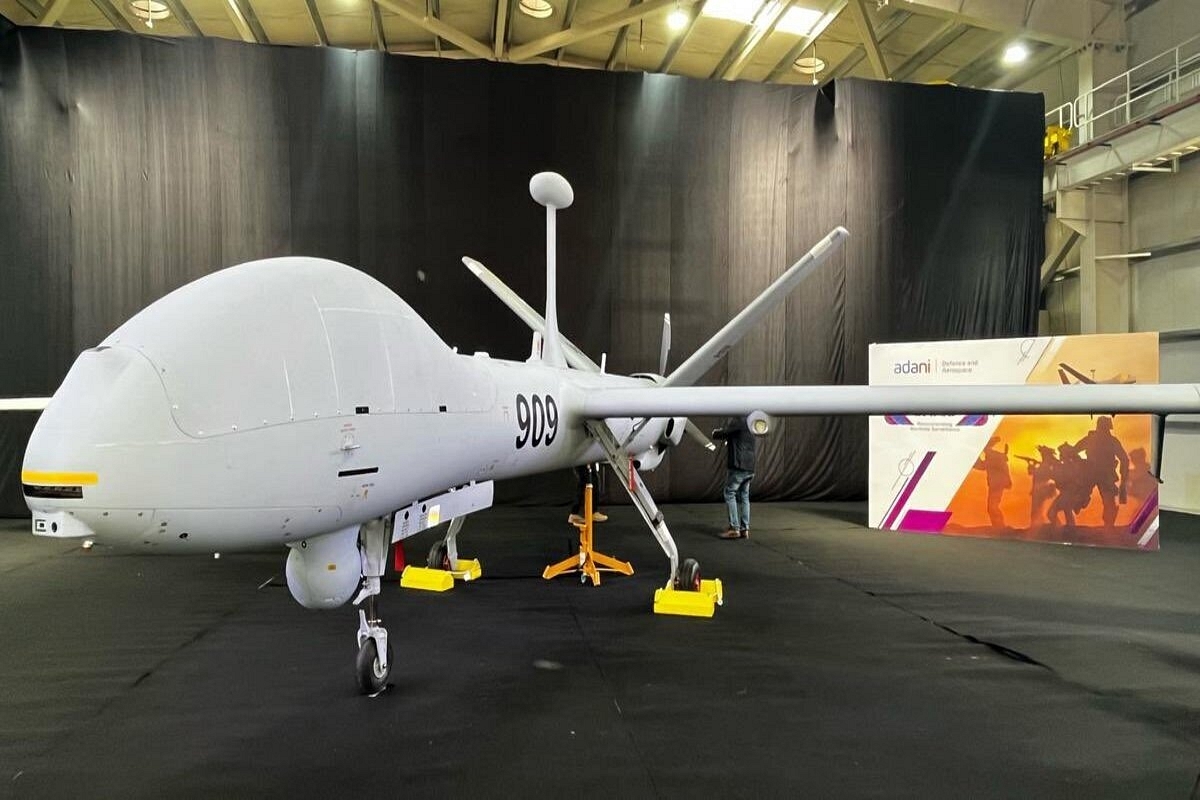Defence
Navy's Drishti Drone: 'Make In India' PR Is Fine As Long As We Know The Truth, Chase Incremental Indigenisation

Adani-Defence Drishti 10 Starliner unmanned aerial vehicle for Indian Navy.
The Indian Navy's latest, Adani Defence-made Drishti 10 Starliner medium altitude long endurance (MALE) unmanned aerial vehicle (UAV) which it received just yesterday (10 January), is not exactly a 'made-in-India' product.
Drishti 10 is just a rebranded version of the Israeli Elbit Systems' Hermes 900 MALE UAVs, currently being assembled at Adani Defence's Hyderabad facility.
Adani Defence inaugurated this facility in 2018 to manufacture MALE UAVs under an agreement with Elbit for producing Hermes 900 and Hermes 450 drones, primarily for the export market. The company has already exported around 20 of these drones to various international customers.
With the capability of surveilling large areas for 36 hours straight and carrying a payload of 450 kg, the Drishti UAVs significantly enhance the long-range search and reconnaissance capabilities of both the army and navy.
This utility was recently demonstrated when the Indian Navy released footage of Marine Commandos (MARCOS) boarding a commercial ship following a pirate attack, a mission supported by UAV surveillance.
However, the rebranding of the Hermes 900 UAV as Drishti 10 Starliner and the public relations campaign by Adani Defence portraying the UAV as an indigenous product give the impression that it was entirely designed and developed in India, which is not the case.
But the rebranding effort wouldn't have any negative consequences if the company is prepared to pursue incremental indigenisation and plans to eventually design and build its own UAVs.
The predicament of Adani Defence to sell an Israeli UAV with an Indian name is understandable since the company does not have a prior experience in designing and manufacturing a UAV on its own. Hence its partnership with Elbit and the consequent rebranding.
This partnership allows the company to gain the technology and experience of the manufacturing of various critical components that have a small margin of error.
This strategy of borrowing knowledge from a more experienced company is beneficial in the short term, and others have used it too.
However, for the medium to long term, this is unsustainable.
The goal should be to absorb the technology transfer to such an extent that the company becomes capable of designing an entirely new UAV in-house.
This includes the full set of capabilities, from conceptualising to manufacturing, testing, and integrating sensors as required by the user, just like what Hindustan Aeronautics Limited (HAL) did with license manufacturing of Mig-21, Mig-27, Jaguar, and Sukhoi-30 MKI fighter jet, to the point of being able to design its own fighter jet, the Tejas.
Similarly, the Heavy Vehicles Factory (HVF) Avadi progressed from assembling the British Vickers Mk1 (Vijayanta tank) and Russian T-72 and T-90 tanks to independently designing and manufacturing the Arjun tank.
Tata's recent venture into manufacturing the Airbus C-295 transport aircraft, which commenced last year (2023), is expected to do just that — designing an indigenous aircraft, and becoming a competitor to HAL.
Looking ahead, until Adani Defence becomes proficient and mature enough to completely design and develop its own in-house UAV, or until the DRDO can deliver on its promise of delivering the Archer-NG (a new in-development UAV) within the required timeline and meeting all requirements, the armed forces will have to rely on imported UAVs for the foreseeable future.
Support Swarajya's 50 Ground Reports Project & Sponsor A Story
Every general election Swarajya does a 50 ground reports project.
Aimed only at serious readers and those who appreciate the nuances of political undercurrents, the project provides a sense of India's electoral landscape. As you know, these reports are produced after considerable investment of travel, time and effort on the ground.
This time too we've kicked off the project in style and have covered over 30 constituencies already. If you're someone who appreciates such work and have enjoyed our coverage please consider sponsoring a ground report for just Rs 2999 to Rs 19,999 - it goes a long way in helping us produce more quality reportage.
You can also back this project by becoming a subscriber for as little as Rs 999 - so do click on this links and choose a plan that suits you and back us.
Click below to contribute.
Latest